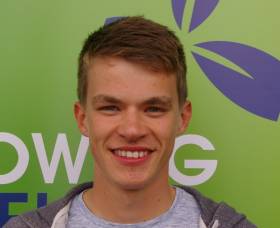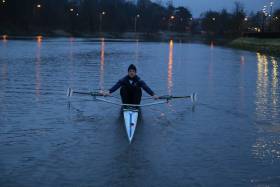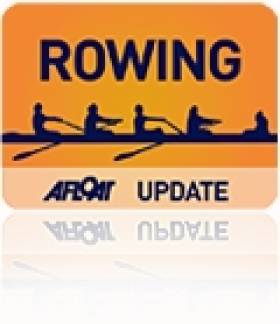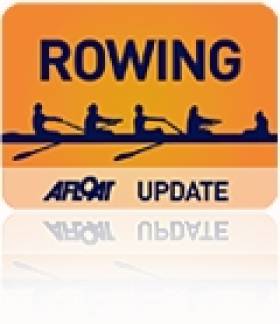Displaying items by tag: University Championships
#Rowing: Trinity won the men’s senior eights at the University Championships of Ireland at the National Rowing Centre in Cork today. The race had a thrilling finish: Trinity led by less than a length, but UCD finished strongly and almost caught them. NUIG won the women’s senior eight much more comfortably, from Trinity.
The overall winners were NUIG, who also won the Bank of Ireland Trophy for women. The men’s award, the Wylie Cup, went to Trinity.
Fintan McCarthy of UCC won the senior single sculls from Andrew Goff of UCD and Selma Bounane of UCC topped the rankings in the women’s senior single.
University Championships of Ireland, National Rowing Centre (Selected Results)
Men
Eights – Senior: 1 Trinity, 2 UCD, 3 UCC. Inter: 1 Trinity, 2 UCD, 3 UCC. Club: 1 Trinity, 2 NUIG, 3 UCC. Novice: 1 UCD A, 2 Trinity A, 3 Queen’s A.
Four – Sen: UCD. Inter, coxed: Trinity. Club, coxed: UCC.
Pair – Sen: UCD.
Sculling, Quadruple, coxed – Novice: University of Limerick. Double – Inter: Queen’s. Single - Sen: UCC (F McCarthy). Inter: Univ of Limerick (K Mannix)
Women
Eights – Senior: 1 NUIG, 2 Trinity A, 3 Trinity B. Inter: 1 NUIG, 2 Trinity A, 3 Queen’s. Club: 1 NUIG, 2 Queen’s, 3 UCD A. Novice: 1 UCD, 2 Queen’s A, 3 Queen’s B.
Four – Sen: NUIG. Inter, coxed: NUIG A. Club, coxed: NUIG A.
Pair – Sen: UCC.
Sculling, Quadruple – Nov: Queen’s B. Double – Inter: NUIG. Single – Sen: UCC (Bounane). Inter: UCC (L Heaphy).
Overall Winners: NUIG. Wylie Cup for Men: Trinity. Bank of Ireland Trophy for Women: NUIG.
#Rowing: Trinity came out on top at the Irish University Rowing Championships at the National Rowing Centre in Cork today. The combined points tally of Dublin University Boat Club and Dublin University Ladies Boat Club was 68 points. UCD’s total was 51 and NUIG’s 43.
The Wylie Cup, calculated on results in the men’s eights, went to UCD, who won the senior eight convincingly from Trinity. NUIG are the Bank of Ireland champions, though UCD won the senior eights.
Stephen O’Connor of UCC beat Patrick Moreau of Trinity in the senior single sculls final, though Andrew Goff of UCD was faster in winning the intermediate title.
Irish University Championships, National Rowing Centre, Friday (Selected Results)
Overall: 1 Trinity (DUBC and DULBC) 68 points, 2 UCD 51, 3 NUIG 43. Wylie Cup (Senior Men, based on results in eights): UCD. Bank of Ireland Cup (Senior Women, eights): NUIG.
Men
Eight – Senior: 1 UCD 6:12.06, 2 Trinity 6:17.82, 3 NUIG 6:26.67. Club: NUIG 6:28.85. Intermediate: UCD 6:17.73. Novice: Queen’s 6:29.09.
Four – Sen: Trinity 7:12.30. Inter, coxed: Dublin IT 7:04.65. Club, coxed: NUIG 7:10.88.
Pair – Sen: Trinity 7:22.44.
Sculling, Quadruple – Nov, coxed: Queen’s A 7:37.40.
Double – Inter: UCC 7:28.18.
Single – Sen: UCC (S O’Connor) 7:58.23. Inter: UCD (A Goff) 7:47.90.
Women
Eight – Senior: 1 UCD 7:06.78, 2 NUIG 7:14.70, 3 Trinity A 7:20.66. Inter: NUIG 7:11.87.
Club: NUIG 7:12.84. Novice: NUIG 7:26.53.
Four – Sen: UCD 7:36.88. Inter, coxed: UCC 8:13.49. Club, coxed: Queen’s 8:12.59.
Pair – Sen: UCD 8:20.97.
Sculling, Quadruple – Nov, coxed: Queen’s 9:08.74.
Double – Inter: Trinity 8:35.31.
Single – Inter: UUC (K Shirlow) 8:46.18.
Doyle the Top Single Sculler at University Championships
#Rowing: Philip Doyle of Queen’s University won the senior single sculls final at the Irish University Championships at the National Rowing Centre in Cork today. UCD had an emphatic win over NUIG in the men’s senior pair, while UCC won the senior four. Trinity won the women’s senior four with less than a length to spare over UCD.
| Irish University Rowing Championships 2016 Results |
|---|
| Time: __09:00_____ Race no. ___1_____ Event ____Mens Senior 1x_____ |
| Final |
| Distance |
| 1st |
| QUBBC (Doyle) |
| 21⁄2L |
| 2nd |
| Belfast Met (McKeown) |
| 1⁄2L |
| 3rd |
| QUBBC (Beck) |
| 11⁄2L |
| 4th |
| UCDBC (Hughes) |
| 1⁄2L |
| 5th |
| DUBC (Corcoran) |
| Distance |
| 6th |
| CORK IT (Merz) |
| Number to qualify for final ______________ |
| Irish University Rowing Championships 2016 Results |
| Time: __09:10______ Race no. _2_______ Event ____W Inter 1x_________ |
| Final |
| Distance |
| 1st |
| UCC (Bouanane) |
| 5L |
| 2nd |
| QUBLBC (Blundell) |
| 4L |
| 3rd |
| UCCRC (O'Sullivan) |
| 11⁄2L |
| 4th |
| DULBC (Foley) |
| 11⁄2L |
| 5th |
| QUBLBC (Brown) |
| 2L |
| 6th |
| NUIM (Byrne) |
| Number to qualify for final ______________ |
| Irish University Rowing Championships 2016 Results |
| Time: __09:40____ Race no. ___5_____ Event __Mens Intermediate 1x__ _____ |
| Final |
| Distance |
| 1st |
| Cork IT (Hennessy) |
| 31⁄2L |
| 2nd |
| UCDBC (Goff) |
| Distance |
| 3rd |
| I.T. Blanchardstown (Gahan) |
| Distance |
| 4th |
| QUBBC (Taylor) |
| 5th |
| DUBC (Hough) DNS |
| DNS |
| 6th |
| Number to qualify for final ______________ |
| Irish University Rowing Championships 2016 Results |
| Time: __10:00______ Race no. _7_______ Event ____Womens Club 4+______ |
| Heat 1 |
| Distance |
| 1st |
| QUBLBC |
| 11⁄2L |
| 2nd |
| DULBC A |
| Distance |
| 3rd |
| ULRC |
| Distance |
| 4th |
| DULBC C |
| 5th |
| 6th |
| Number to qualify for final _____3_________ |
| Irish University Rowing Championships 2016 Results |
| Time: __10:10____ Race no. ___8_____ Event __Womens Club 4+__ _____ |
| Heat 2 |
| Distance |
| 1st |
| UCCRC |
| 1⁄2L |
| 2nd |
| DULBC B |
| Distance |
| 3rd |
| Dublin IT |
| 4th |
| 5th |
| 6th |
| Number to qualify for final ____2__________ |
| Irish University Rowing Championships 2016 Results |
| Time: __10:20 ______ Race no. _9_______ Event ____Mens Novice 8+___ |
| Heat 1 |
| Distance |
| 1st |
| UCDBC A |
| 4L |
| 2nd |
| NUIG |
| 2L |
| 3rd |
| DUBC C |
| 2L |
| 4th |
| QUBBC B |
| 5th |
| 6th |
| Number to qualify for final _____3_________ |
| Irish University Rowing Championships 2016 Results |
| Time: __10:30____ Race no. ___10_____ Event __Mens Novice 8+ _____ |
| Heat 2 |
| Distance |
| 1st |
| DUBC A |
| 3L |
| 2nd |
| DUBC B |
| 1L |
| 3rd |
| QUBBC A |
| Distance |
| 4th |
| ULRC |
| 5th |
| 6th |
| Number to qualify for final ____3__________ |
| Irish University Rowing Championships 2016 Results |
| Time: __10:40 ______ Race no. _11_______ Event __Womens Intermediate 2x___ |
| Final |
| Distance |
| 1st |
| DULBC A |
| 2L |
| 2nd |
| UCCRC |
| 11⁄2L |
| 3rd |
| QUBLBC |
| 1⁄2L |
| 4th |
| DULBC B |
| 6L |
| 5th |
| NUIG |
| 6th |
| Number to qualify for final ______________ |
| Irish University Rowing Championships 2016 Results |
| Time: __10:50____ Race no. ___12_____ Event __Mens Senior 2-_____ |
| Final |
| Distance |
| 1st |
| UCDBC |
| 6L |
| 2nd |
| NUIG |
| 6L |
| 3rd |
| DUBC A |
| 4L |
| 4th |
| QUBBC |
| 1L |
| 5th |
| DIT RC |
| 6th |
| Number to qualify for final ______________ |
| Irish University Rowing Championships 2016 Results |
| Time: _ _11:00_____ Race no. ___13_____ Event __Womens Senior 2-___ |
| Final |
| Distance |
| 1st |
| DULBC |
| 31⁄2L |
| 2nd |
| QUBLBC |
| 3rd |
| 4th |
| 5th |
| 6th |
| Number to qualify for final ______________ |
| Irish University Rowing Championships 2016 Results |
| Time: _ _11:10_____ Race no. ___14_____ Event __Womens Novice 8+__ |
| Final |
| Distance |
| 1st |
| UCDBC |
| 21⁄2L |
| 2nd |
| DULBC A |
| 4L |
| 3rd |
| QUBLBC |
| 1ft |
| 4th |
| DULBC B |
| 5th |
| 6th |
| Number to qualify for final ______________ |
| Irish University Rowing Championships 2016 Results |
| Time: _ _11:20_____ Race no. ___15_____ Event __Womens Novice 4x+-___ |
| Final |
| Distance |
| 1st |
| Dublin IT A |
| Distance |
| 2nd |
| ULRC |
| Distance |
| 3rd |
| NUIG |
| 5L |
| 4th |
| Dublin IT B |
| 5th |
| 6th |
| Number to qualify for final _____________ |
| Irish University Rowing Championships 2016 Results |
| Time: _ _11:50_____ Race no. ___17_____ Event __Mens Senior 4- |
| Final |
| Distance |
| 1st |
| UCCRC |
| Canvas |
| 2nd |
| DUBC |
| 1L |
| 3rd |
| UCDBC |
| 4th |
| 5th |
| 6th |
| Number to qualify for final _____________ |
| Irish University Rowing Championships 2016 Results |
| Time: _ _12:00_____ Race no. ___18_____ Event __Mens Club 8+_____ |
| Final |
| Distance |
| 1st |
| NUIG |
| 11⁄4L |
| 2nd |
| D.I.T RC |
| 1⁄2L |
| 3rd |
| QUBBC |
| 1⁄2L |
| 4th |
| UCCRC |
| 1L |
| 5th |
| DUBC A |
| 6th |
| Number to qualify for final _____________ |
| Irish University Rowing Championships 2016 Results |
| Time: __12:10_____ Race no. ___19_____ Event __Womens Club 8+_____ |
| Final |
| Distance |
| 1st |
| QUBLBC |
| 21⁄2L |
| 2nd |
| UCDBC |
| 2L |
| 3rd |
| ULRC |
| 11⁄2L |
| 4th |
| UCCRC |
| 2L |
| 5th |
| DULBC A |
| Distance |
| 6th |
| DULBC B |
| Number to qualify for final _____________ |
| Irish University Rowing Championships 2016 Results |
| Time: __12:20_____ Race no. ___20_____ Event __Womens Senior 4-_____ |
| Final |
| Distance |
| 1st |
| DULBC A |
| 3⁄4L |
| 2nd |
| UCDBC |
| Distance |
| 3rd |
| DULBC C |
| 2L |
| 4th |
| DULBC B |
| 5th |
| 6th |
| Number to qualify for final _____________ |
| Irish University Rowing Championships 2016 Results |
| Time: __12:40_____ Race no. ___22_____ Event __Mens Novice 8+_____ |
| Final |
| Distance |
| 1st |
| DUBC A |
| 21⁄2L |
| 2nd |
| UCDBC |
| 21⁄2L |
| 3rd |
| QUBBC |
| 1/3 L |
| 4th |
| DUBC B |
| Distance |
| 5th |
| NUIG |
| 1L |
| 6th |
| DUBC C |
| Number to qualify for final _____________ |
| Irish University Rowing Championships 2016 Results |
| Time: __13:00_____ Race no. ___24_____ Event __Womens Club 4+_____ |
| Final |
| Distance |
| 1st |
| DULBC A |
| 1⁄2 canvas |
| 2nd |
| QUBLBC |
| 6L |
| 3rd |
| DULBC B |
| 2L |
| 4th |
| ULRC |
| 21⁄2L |
| 5th |
| UCCRC |
| 6th |
| Number to qualify for final _____________ |
Trinity Win Senior Eights But UCD Take Wylie and BoI Trophies
#ROWING: UCD took the Wylie Cup for men and the Bank of Ireland Cup for women at the University Championships of Ireland at the National Rowing Centre in Cork today. Under the new rules two wins in eights across the grades of Novice, Intermediate, Club and Senior grades sufficed. UCD won the men’s Novice and Club eights and the Novice and Intermediate in women’s eights.
It was, however, a particularly good day for Trinity. They bested UCD in both the senior men’s and women’s eights and won the overall points classification.
University Championships of Ireland, National Rowing Centre (Selected Results)
Men
Wylie Cup: UCD
Eight – Senior: 1 Trinity, 2 NUIG, 3 UCD. Club: 1 UCD A, 2 Trinity, 3 Queen's. Intermediate: 1 NUIG, 2 Trinity, 3 UCD A. Novice: 1 UCD A, 2 Trinity A, 3 Queen’s A.
Four – Club, coxed: UCD A.
Pair – Senior: UCC.
Sculling, Quadruple – Senior: UCC. Novice: Queen’s. Double – Intermediate: Cork IT. Single – Senior: 1 Univ of Limerick (M O’Donovan). - Intermediate: UCC (S O’Connor).
Women
Bank of Ireland Cup: UCD
Eight – Senior: 1 Trinity B, 2 UCD, 3 Trinity A. Club: 1 NUIG, 2 Queen's, 3 Trinity. Intermediate: 1 UCD, 2 NUIG, 3 Trinity. Novice: 1 UCD, 2 Queen’s A, 3 Trinity B.
Four – Senior: Trinity B. Club, coxed: NUIG. Intermediate, coxed: UCC.
Sculling, Quadruple – Novice, coxed: NUIG. Double – Intermediate: Trinity B.
Single – Intermediate: Trinity (S Dolan).
Overall Points Winners: Trinity.
UCD's Men and Women Take Irish University Honours
#UNIVERSITY ROWING: UCD took the Wylie Cup for men and the Bank of Ireland Cup for women at the rescheduled Irish University Championships at Blessington Lakes tonight. Trinity won the novice eight categories for both women and men, but UCD won both intermediate and senior eights races. In senior men’s eights, NUIG took second, while UCD vanquished their only rivals, Trinity, in the women’s senior eights.
The weather had forced the postponement of the Championships originally and winds were again a factor tonight, with all but these six races stripped from the programme.

































































